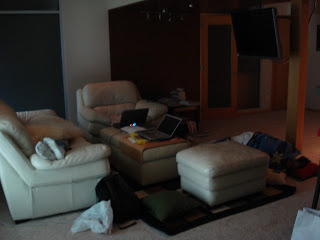Putting Fun Into a Press Kit
In preperation for the future, and as an unfortunate necessity, we got together on Wednesday to go over business stuff and set up some things for a press kit. Part of the press kit was a group photo, so we tried to have as much fun as possible having a photo shoot. Here are some of the results:

We found a sweet beat-up VW Minibus that had been sitting in that spot for the last 10 years. Of course we wanted to get our picture taken with it. While we were taking pictures, a man who worked at the car shop nearby offered to sell it to us. It needed more love than we were willing to give it, though.

The day before, Mike was showing us the iconic James Bond poses that each Bond actor had adopted. It was really entertaining. Randomly, someone mentioned we should strike a Bond pose, so because we're dorks, we gave it a shot. This is probably our favorite photo of the whole group.

We figured the abandoned factory would be a great setting for our photos. So this photo is meant to show it off. My favorite part is the fact that every vehicle in the background is at least 10-15 years old. It makes me think of Eastern Europe.

Not an official press photo per se, but appropriate enough anyway. Currently, only Mike lives in Ames, and since that's where we met, we crashed at his place. It was unseasonably cool that night, so Ted and I wrapped up in our blankets. We looked pretty silly, and that inspired a group photo with all of us snuggled up on the couch.


There's still debate about these two. We all admit they're kind of rock-band-pretentious, but the debate is over whether that can be a good thing or not. :P
Our lawyer told us that apparently, it's a good idea for legal reasons to have official titles for your LLC. Something about the government and documents, blah blah blah...
Well at Intuition Games, we see ourselves as equals, with no person having authority over anyone else. It's just that different people have different roles they take on. We applied that mentality to choosing official titles by drawing names out of Ted's trumpet case to decide who would get which title. And we forced Ted to play his trumpet between each draw. :)


Ted is well-known for his creative genius when it comes to seating posture. If there was ever a competition for most interesting position while working at a computer, Ted would win hands down. Here's a good example:

Despite some draining business discussions, the whole thing was quite fun. Maybe someday the press photos will actually be put to use. Nah... :P















